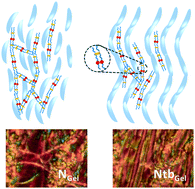Effect of gelation on the Frank elastic constants in a liquid crystalline mixture exhibiting a twist bend nematic phase†
Abstract
We report studies on the Frank elastic constant behaviour of a liquid crystal gel system exhibiting the twist bend nematic (Ntb) phase. Physical gelation is observed to ease the splay and stabilize the twist deformations in the nematic phase preceding the Ntb. More importantly, the ultra-low bend elastic constant (K33) of the system is enhanced by an order of magnitude on gelation. The magnitude of K33 remains high even in the vicinity of the Ntb phase, which otherwise is susceptible to bend deformations. This phenomenon is explained from the point of view of polar interactions in the Ntb system. XRD and dynamic rheology along with the elastic constant data validate this argument. Another salient feature of the system is that gel fibers grown in the direction orthogonal to the helical axis vanish in the Ntb phase as observed from polarizing optical microscopy. A possible reason for this is discussed on the basis of ordering developed in the surrounding medium. This feature gives the possibility of using the Ntb phase as a tool to imprint directional microstructures with a gel network.



 Please wait while we load your content...
Please wait while we load your content...